
A dragonfly is a flying insect belonging to the infraorder Anisoptera below the order Odonata. About 3,000 extant species of true dragonflies are known. Most are tropical, with fewer species in temperate regions. Loss of wetland habitat threatens dragonfly populations around the world. Adult dragonflies are characterized by a pair of large, multifaceted, compound eyes, two pairs of strong, transparent wings, sometimes with coloured patches, and an elongated body. Many dragonflies have brilliant iridescent or metallic colours produced by structural coloration, making them conspicuous in flight. An adult dragonfly's compound eyes have nearly 24,000 ommatidia each.
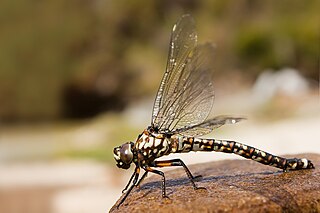
The Aeshnidae, also called aeshnids, hawkers, or darners, is a family of dragonflies. The family includes the largest dragonflies found in North America and Europe and among the largest dragonflies on the planet.

The green darner or common green darner, after its resemblance to a darning needle, is a species of dragonfly in the family Aeshnidae. One of the most common and abundant species throughout North America, it also ranges south to Panama. It is well known for its great migration distance from the northern United States south into Texas and Mexico. It also occurs in the Caribbean, Tahiti, and Asia from Japan to mainland China. It is the official insect for the state of Washington in the United States.

Ischnura senegalensis, also known variously as common bluetail, marsh bluetail, ubiquitous bluetail, African bluetail, and Senegal golden dartlet, is a widespread damselfly of the family Coenagrionidae. It is native from Africa, through the Middle East, to southern and eastern Asia.

Anax ephippiger, the vagrant emperor, is a species of dragonfly in the family Aeshnidae. It migrates to Afro-tropical, Europe, central and southern Asia through monsoon winds.

Anax guttatus, the pale-spotted emperor or lesser green emperor, is a dragonfly of the family Aeshnidae.
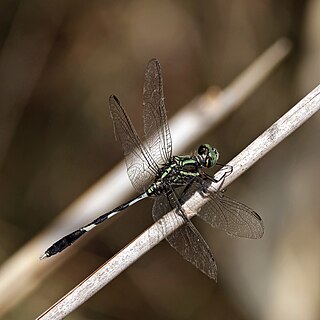
Orthetrum sabina, the slender skimmer or green marsh hawk, is a species of dragonfly in the family Libellulidae. It is widespread, being found from south-eastern Europe and North Africa to Japan and south to Australia and Micronesia.

Eastern forktail is a member of the damselfly family Coenagrionidae.

The shadow darner is a species of dragonfly in the family Aeshnidae. It is found in almost all of Canada and most states in the United States.

Anax parthenope, the lesser emperor, is a dragonfly of the family Aeshnidae. It is found in Southern Europe, North Africa, Middle East and Asia.

Aeshna canadensis, the Canada darner, is a species of dragonfly in the family Aeshnidae. It is common throughout southern Canada and the northern United States.

Triacanthagyna is a genus of dragonflies in the family Aeshnidae. The species have large eyes and broad wings. The females have three prominent spines under the last abdominal segment which gives the genus its name. They are commonly known as three-spined darners.
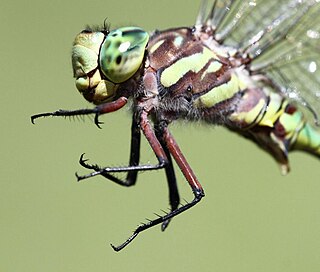
Pinheyschna subpupillata, the stream hawker, is a species of dragonfly in the family Aeshnidae.
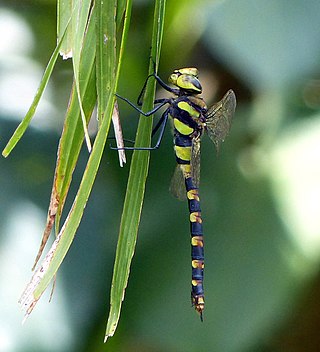
Anax immaculifrons, the magnificent emperor, or blue darner, is a species of dragonfly in the family Aeshnidae. It is found in many Asian countries and very few European countries.

Ischnura erratica, the swift forktail, is a species of damselfly in the family Coenagrionidae. It is native to the Pacific Northwest, ranging from British Columbia to northern California.

Austroaeschna speciosa is a species of dragonfly in the family Telephlebiidae, known as the tropical unicorn darner. It is known to be present only in the mountainous regions of north-east Queensland, Australia. It appears very similar to the more widespread Austroaeschna unicornis which inhabits areas in southern Queensland, New South Wales, Victoria and Tasmania.

Anaciaeschna jaspidea is a species of dragonfly in the family Aeshnidae, commonly known as the Australasian duskhawker and Rusty darner. It widely distributed from India through Australia to the Pacific.
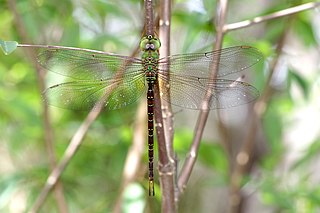
Gynacantha rosenbergi is a species of dragonfly in the family Aeshnidae, known as the grey duskhawker. It inhabits still waters and is found in New Guinea, Indonesia, through parts of northern Australia, as well as islands in the south Pacific.

Gynacantha bayadera, parakeet darner or small duskhawker, is a species of dragonfly in the family Aeshnidae. It is found from India to South China and northern New Guinea. This is a crepuscular species which probably breeds in forested swamps and marshy areas, or in forest pools.
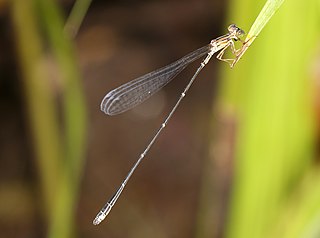
Oristicta filicicola is a species of damselfly belonging to the family Isostictidae. Until 2017 it was the only species of the genus Oristicta. Commonly known as a slender wiretail, it is a slender and dull-coloured damselfly of medium-size. It is endemic to north-eastern Australia, where it inhabits streams in rainforests.




















